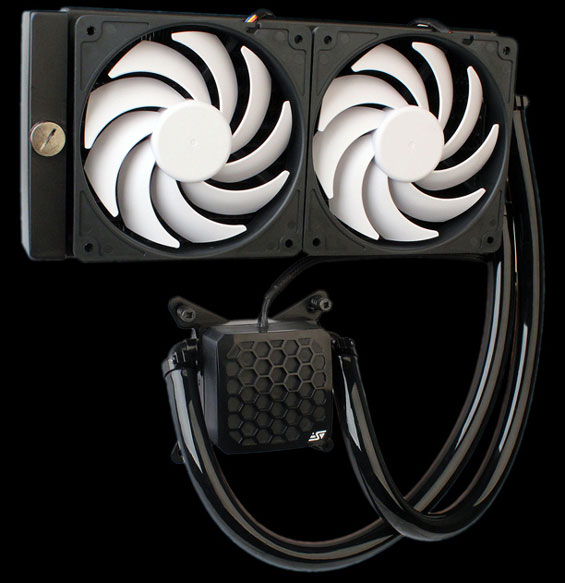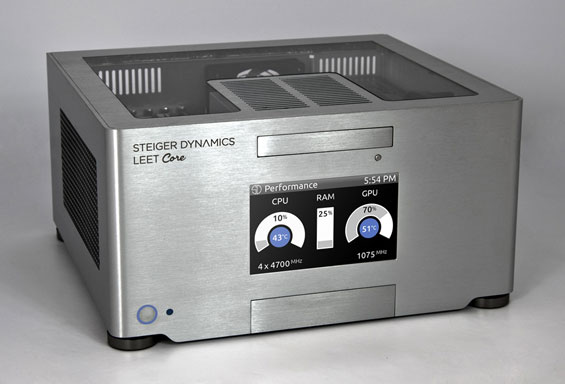Swiftech and Steiger Dynamics: German Engineering Comes Home
by Dustin Sklavos on January 14, 2013 3:34 AM ESTI don't know about you, but for me, the word "engineering" gets a lot more enticing when it's preceded by the word "German" (or the phrase "Commander LaForge, please report to.") Nanoxia, Swiftech, and Steiger Dynamics were all sharing a suite at CES this year, and while I've seen most of what Nanoxia has to offer with the Deep Silence 1, Swiftech and Steiger Dynamics were another thing entirely.
My meeting with Swiftech was brief and focused predominately on their new H220 closed-loop cooler. While they've offered watercooling kits of all types for a long time now, the H220 is targeted squarely at the market being served by Corsair's H100i, Thermaltake's Big Water 2.0 Extreme, and NZXT's Kraken X60. The H220 really screams quality, though, and you can tell Swiftech has been in the watercooling game for some time when you start examining the details.

Unlike most competing solutions, the H220's reservoir can be refilled, and the radiator uses brass tubing surrounded by copper fins (most closed-loop coolers sourced from Asetek or CoolIT rely on aluminum fins in the radiator). If you open the cooling loop (and Swiftech has designed the H220 for exactly that), the pump on the CPU waterblock is actually capable of handling the thermal load from an overclocked processor and two GeForce GTX 680s.
Swiftech had four comparison systems on display to show just how much better the H220 was than Thermaltake and Corsair's solutions, with each system employing a 240mm cooler from each company and the fourth with the H220's cooling loop including two GTX 680s. The H220 was able to either perform roughly 5C or so better than the competitors at comparable or lower noise levels. While I'm skeptical about the comparison systems (no two i7-3770Ks overclock exactly the same), I'm still pretty confident the H220 will be a force to be reckoned with.
Swiftech's H220 will be retailing with an MSRP of $139.
Meanwhile, Ganesh was gracious enough to coordinate a meeting between me and freshly minted system integrator Steiger Dynamics. Steiger Dynamics has one product, but it's a doozy: the LEET. While the name may not excite you, the product ought to at least pique your interest.

The LEET is essentially a custom desktop designed to be a media center, and specifically, a gaming machine. While comparable products like the DigitalStorm Bolt, the iBuyPower Revolt, and Alienware's X51 all look more like gaming consoles and were designed to see just how much power could be crammed within a specific envelope, the LEET goes in the opposite direction. Steiger Dynamics has produced something that looks like a home theater appliance, and within the enclosure is a custom liquid cooling loop (produced with Swiftech's aid, naturally) capable of supporting an Intel Sandy Bridge-E hexa-core Core i7 along with dual GeForce GTX 690s.
Where this product proves itself, though, is in how silently it runs. While pushing the CPU and graphics hardware at full bore (we're talking Prime95 plus FurMark) will produce an audible increase in noise, in gaming the LEET is essentially silent. I tried Crysis 2 and Far Cry 3, both at their maximum 1080p settings, and I didn't hear a peep from the system on display.
Steiger is still small, but they have a very attractive product. The price is going to put it out of reach for a lot of users (it starts at a not inconsiderable $1,798), but for those that can afford it, it's going to be a very impressive machine. This isn't something that can be easily built off of the shelf, and it shows. Expect to hear more from Steiger Dynamics in the future.










7 Comments
View All Comments
Beenthere - Monday, January 14, 2013 - link
I know the technically challenged still think anything that uses water cooling is more thermally efficient than air cooling, but accurate testing by numerous websites proves this simply is not true with closed loop coolers. Swiftech's solution would not need to be much better to be better than Corsair's or similar CLCs as most highend HSFs are thermally more efficient, cost substantially less (like 1/2 the price) and the HSFs are noticeably quieter and HSFs never leak water and damage hardware as the closed loop coolers have done and will continue to do.Swiftech generally makes good quality products and hopefully their product is better than the other mediocre closed loop coolers from other sources, but there is still the cost and leak issues to consider even if they have managed to lower the fan noise to that of a highend HSF. The $100+ closed loop cooler kits are just a poor choice for 99% of PC enthusiasts if your primary criteria for determining the merits of a CPU cooling system are based on thermal performance, cost, noise and reliability. Few people want to admit that these closed loop coolers are a poor choice but they are if you are objective and not looking thru rose colored glasses.
grouchon - Monday, January 14, 2013 - link
Hi There, this is Gabe (Swiftech CEO), and thanks for your comments.We tested the excellent Noctua DH14 against the H220 cooler; using a 3930K @4.5G and 1.448v under 100% CPU stress (CPU-burn), we measured delta T (above ambient) of 51.3C @ 1300 rpm & 23 dBA (fan rating) for DH14 vs. 48.4 for H220 @ same fan speed and 22 dBA (fan rating).
I completely agree that spending any $ for a liquid cooling system if it doesn't outclass the best air coolers both in temps and noise level is nonsense. Accordingly, we would't release a product if such was not the case :-)
Vatharian - Tuesday, January 15, 2013 - link
Problem is, that high-end air coolers have usually more surface to spread heat, than single 120- or 140mm radiator. Things even out at 240 or 280mm radiator, and even then there is hard limit of maximal 'tdp capacity' of liquid cooler. For example it's physically impossible to cool heavy OCed 3960X with single-radiator cooler, even with delta T at 20 or 30 degrees Celsius and with couple of San Ace 6k rpm beasts, but it's perfectly doable with double radiator, albeit with disappointing acoustics. That's why products like H60, H70 and similar products and other will always loose at comparison to comparably priced air cooler. Then we go up and we get to the area, when self-built LC loop is available. Margin here is very thin, and H220 may be BIG bullseye here! The simplicity that cpu-block mounted pump brings is astonishing, especially when you can buy only one or two such things already and in two places in the world only. However, I'm worried by two things: Customers gonna believe, that you can cool OCed cpu and two 680s with double radiator, which is simply not possible. What about adding more radiators? Will normal off the shelf rads will fit? And also pump that can push this probably is quite powerful, which brings up the question on vibrations applied directly to cpu-block contact surface - tim filled, possibly worsening heat transfer. Has this bean taken care of?Nickel020 - Monday, January 21, 2013 - link
If Swiftech says that this unit performs better than a Noctua DH14 temperature and noise wise, then you can trust that statement. Swiftech has for many years released internal performance data and that data has always been confirmed by independent testers like Vapor or Martin over at xtreme systems.I've been watercooling for quite a few years, and this is the first AIO solution that actually deserves the name watercooling. This thing comes with a great cooling plate, same as the Apogee Drive 2 (one of the top coolers), a much stronger pump than the competitors (more flow means lower temperatures), and a copper/brass radiator instead of an aluminum radiator (which also means lower temperatures).
In Swiftech's showcase at CES this unit performed better than the Corsair H100i even though the Corsair uses 2700 RPM fans vs. Swiftech's 1800 RPM. Given Swiftech's history of credibiliy I highly doubt they rigged that test. Look at the showcase and what Linus has to say about Swiftech's credibility:
http://www.youtube.com/watch?feature=player_detail...
And I haven't even mentioned the ability to expand this unit with more radiators for even better cooling (lower water temp = lower CPU temp) or the ability to add in video cards other motherboards to the loop.
For most people, this is the real deal, real watercooling at a superb price. It might not be perfect for ultra silent enthusiasts like me who are used to custom water cooling, but then I'm still pretty excited about this product! This is what the water cooling community has been waiting for, an expandable and affordable AIO solution to get started!
Earthmonger - Monday, January 14, 2013 - link
Can you clarify that statement, Dustin?"If you open the cooling loop (and Swiftech has designed the H220 for exactly that), the pump on the CPU waterblock is actually capable of handling the thermal load from an overclocked processor and two GeForce GTX 680s."
Are you referring to restriction here, rather than heat? The pump is irrelevant where heatload is concerned. Not sure why you even mentioned it. I'd be far more interested to see what the heatload of a CPU and 2 GPUs would be like on that tiny little radiator.
alek1111 - Thursday, January 17, 2013 - link
Anyone know when i can buy this in EU, Norway?alek1111 - Thursday, January 17, 2013 - link
i found out its not announced yet so nvm..